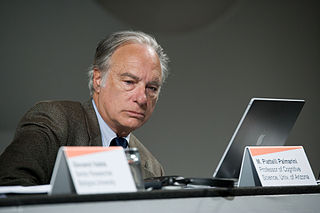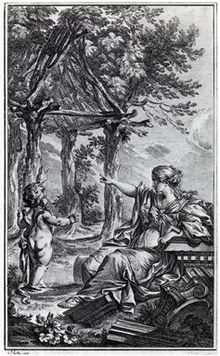
A concept is defined as an abstract idea. It is understood to be a fundamental building block underlying principles, thoughts and beliefs. Concepts play an important role in all aspects of cognition. As such, concepts are studied within such disciplines as linguistics, psychology, and philosophy, and these disciplines are interested in the logical and psychological structure of concepts, and how they are put together to form thoughts and sentences. The study of concepts has served as an important flagship of an emerging interdisciplinary approach, cognitive science.
A paradigm shift is a fundamental change in the basic concepts and experimental practices of a scientific discipline. It is a concept in the philosophy of science that was introduced and brought into the common lexicon by the American physicist and philosopher Thomas Kuhn. Even though Kuhn restricted the use of the term to the natural sciences, the concept of a paradigm shift has also been used in numerous non-scientific contexts to describe a profound change in a fundamental model or perception of events.
Systems theory is the transdisciplinary study of systems, i.e. cohesive groups of interrelated, interdependent components that can be natural or artificial. Every system has causal boundaries, is influenced by its context, defined by its structure, function and role, and expressed through its relations with other systems. A system is "more than the sum of its parts" by expressing synergy or emergent behavior.

Thomas Reid was a religiously trained Scottish philosopher best known for his philosophical method, his theory of perception, and its wide implications on epistemology, and as the developer and defender of an agent-causal theory of free will. He also focused extensively on ethics, theory of action, language and philosophy of mind.
Evolutionary economics is a school of economic thought that is inspired by evolutionary biology. Although not defined by a strict set of principles and uniting various approaches, it treats economic development as a process rather than an equilibrium and emphasizes change, innovation, complex interdependencies, self-evolving systems, and limited rationality as the drivers of economic evolution. The support for the evolutionary approach to economics in recent decades seems to have initially emerged as a criticism of the mainstream neoclassical economics, but by the beginning of the 21st century it had become part of the economic mainstream itself.
Software design is the process by which an agent creates a specification of a software artifact intended to accomplish goals, using a set of primitive components and subject to constraints. The term is sometimes used broadly to refer to "all the activity involved in conceptualizing, framing, implementing, commissioning, and ultimately modifying" the software, or more specifically "the activity following requirements specification and before programming, as ... [in] a stylized software engineering process."
Conceptual semantics is a framework for semantic analysis developed mainly by Ray Jackendoff in 1976. Its aim is to provide a characterization of the conceptual elements by which a person understands words and sentences, and thus to provide an explanatory semantic representation. Explanatory in this sense refers to the ability of a given linguistic theory to describe how a component of language is acquired by a child.

Argumentation theory is the interdisciplinary study of how conclusions can be supported or undermined by premises through logical reasoning. With historical origins in logic, dialectic, and rhetoric, argumentation theory includes the arts and sciences of civil debate, dialogue, conversation, and persuasion. It studies rules of inference, logic, and procedural rules in both artificial and real-world settings.
The term conceptual model refers to any model that is formed after a conceptualization or generalization process. Conceptual models are often abstractions of things in the real world, whether physical or social. Semantic studies are relevant to various stages of concept formation. Semantics is fundamentally a study of concepts, the meaning that thinking beings give to various elements of their experience.

Scientific modelling is an activity that produces models representing empirical objects, phenomena, and physical processes, to make a particular part or feature of the world easier to understand, define, quantify, visualize, or simulate. It requires selecting and identifying relevant aspects of a situation in the real world and then developing a model to replicate a system with those features. Different types of models may be used for different purposes, such as conceptual models to better understand, operational models to operationalize, mathematical models to quantify, computational models to simulate, and graphical models to visualize the subject.

Joseph Rykwert CBE is Paul Philippe Cret Professor Emeritus of Architecture at the University of Pennsylvania, and one of the foremost architectural historians and critics of his generation. He has spent most of his working life in the United Kingdom and America. He has taught the history and theory of architecture at several institutions in Europe and North America. Rykwert is the author of many influential works on architecture, including The Idea of a Town (1963), On Adam's House in Paradise (1972), The Dancing Column (1996) and The Seduction of Place (2000). All his books have been translated into several languages.
Warwick Fox is an Australian-UK philosopher. He is Emeritus Professor of Philosophy, University of Central Lancashire, and his books include Toward a Transpersonal Ecology: Developing New Foundations for Environmentalism;Ethics and the Built Environment (ed.); A Theory of General Ethics: Human Relationships, Nature, and the Built Environment; and On Beautiful Days Such as This: A Philosopher's Search for Love, Work, Place, Meaning, and Suchlike. His main areas of philosophical interest are environmental philosophy, General Ethics, and the nature of the interior lives of humans and other animals.
Public administration theory refers to the study and analysis of the principles, concepts, and models that guide the practice of public administration. It provides a framework for understanding the complexities and challenges of managing public organizations and implementing public policies.

Biolinguistics can be defined as the study of biology and the evolution of language. It is highly interdisciplinary as it is related to various fields such as biology, linguistics, psychology, anthropology, mathematics, and neurolinguistics to explain the formation of language. It seeks to yield a framework by which we can understand the fundamentals of the faculty of language. This field was first introduced by Massimo Piattelli-Palmarini, professor of Linguistics and Cognitive Science at the University of Arizona. It was first introduced in 1971, at an international meeting at the Massachusetts Institute of Technology (MIT).

Nikos Angelos Salingaros is a mathematician and polymath known for his work on urban theory, architectural theory, complexity theory, and design philosophy. He has been a close collaborator of the architect Christopher Alexander, with whom Salingaros shares a harsh critical analysis of conventional modern architecture. Like Alexander, Salingaros has proposed an alternative theoretical approach to architecture and urbanism that is more adaptive to human needs and aspirations, and that combines rigorous scientific analysis with deep intuitive experience.

Juan Bautista Villalpando also Villalpandus, or Villalpanda was a Spanish priest of Sephardic ancestry, a member of the Jesuits, a scholar, mathematician, and architect.

Sociological, psychological, and anthropological theories about religion generally attempt to explain the origin and function of religion. These theories define what they present as universal characteristics of religious belief and practice.
Systems theory in anthropology is an interdisciplinary, non-representative, non-referential, and non-Cartesian approach that brings together natural and social sciences to understand society in its complexity. The basic idea of a system theory in social science is to solve the classical problem of duality; mind-body, subject-object, form-content, signifier-signified, and structure-agency. Systems theory suggests that instead of creating closed categories into binaries (subject-object), the system should stay open so as to allow free flow of process and interactions. In this way the binaries are dissolved.

The term chemoton refers to an abstract model for the fundamental unit of life introduced by Hungarian theoretical biologist Tibor Gánti. Gánti conceived the basic idea in 1952 and formulated the concept in 1971 in his book The Principles of Life. He suggested that the chemoton was the original ancestor of all organisms.

Branchwork or branch tracery is a type of architectural ornament often used in late Gothic architecture and the Northern Renaissance, consisting of knobbly, intertwined and leafless branches. Branchwork was particularly widespread in Central European art between 1480 and 1520 and can be found in all media. The intellectual origin of branchwork lies in theories in Renaissance humanism about the origins of architecture in natural forms and barely-treated natural materials.











